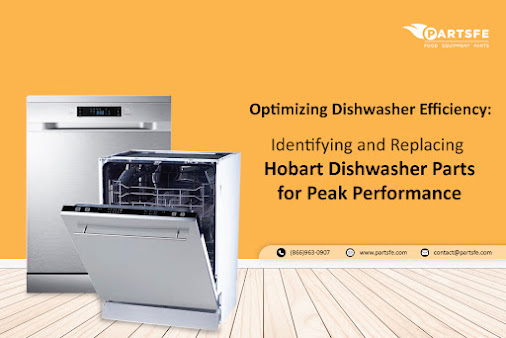Optimizing Dishwasher Efficiency: Identify and Replace Dishwasher Parts
Encountering a malfunction in your restaurant's dishwasher is never ideal, be it at the crack of dawn, amidst a bustling shift, or during the post-dinner rush. Dishwashers, renowned for their durability and power, are a mainstay in professional kitchens worldwide. Nevertheless, even the sturdiest of machines undergo wear and tear as time progresses, resulting in a decline in both efficiency and performance. Recognizing the telltale signs of worn-out parts and taking proactive steps to replace your commercial dishwasher parts can keep your dishwasher humming along seamlessly.
Diagnosing the decline:
The first step to optimizing your commercial dishwasher's efficiency is identifying the problem areas. Keep an eye out for these indicators:
Increased washing times: If your dishwasher seems to take longer than usual to complete a cycle, clogged wash arms, worn-out spray nozzles, or a faulty circulation pump could be to blame.
Dirty dishes: Dishes emerging with food residue point to inadequate cleaning. This could be due to a malfunctioning wash pump, worn-out gaskets on the wash door, or a clogged drain filter.
Excessive water usage: Leaky connections, a faulty water inlet valve, or a defective rinse aid dispenser can significantly inflate your water consumption.
Abnormal noises: Grinding or squealing sounds during operation often indicate worn-out bearings in the wash pump or motor. Disregarding these sounds may result in more significant damage in the future.
Replacing for peak performance:
Once you've identified the culprits, replacing the necessary parts is key. Replace the worn-out parts of a dishwasher with genuine ones to ensure optimal compatibility and performance. Here are some common replacements to consider:
Wash arms and nozzles: Clogged or damaged wash arms and nozzles hinder water flow and cleaning effectiveness. Regular cleaning and periodic replacements are crucial.
Wash pump and motor: A worn-out pump or motor translates to inadequate water pressure and reduced cleaning power. Replacing these components can revitalize your dishwasher.
Gaskets and seals: Leaky gaskets around the wash door allow dirty water to escape, compromising cleaning and increasing water usage. Replacing them ensures a tight seal and efficient operation.
Drain filter: A clogged drain filter restricts water flow and can even lead to overflowing. Regular cleaning and occasional replacements are essential.
Water inlet valve and rinse aid dispenser: A faulty water valve can lead to leaks and inconsistent water flow, while a malfunctioning dispenser can compromise rinse results. Replacing these components optimizes water usage and cleaning efficacy.
Preventative measures:
Taking a preemptive approach to maintenance can elongate the operational life of your commercial dishwasher and reduce the frequency of necessary replacements for dishwasher parts.
Regular cleaning: Maintain peak water flow and prevent blockages by cleaning the wash arms, nozzles, and filters regularly.
Proper loading: Follow the manufacturer's recommended loading patterns to maximize cleaning efficiency and minimize the risk of damaging dishes or the machine itself.
Use appropriate detergents and rinse aids: Use high-quality, approved detergents and rinse aids to ensure effective cleaning and protect your dishwasher's components.
Commercial dishwasher error codes:
Every now and then, you might encounter an error code flashing on your dishwasher's display. Usually, these codes are straightforward to decipher and resolve, but if uncertainty creeps in, refer to this comprehensive list of commercial dishwasher codes for insights into their meanings and potential solutions.
By recognizing the signs of worn-out parts, replacing them promptly with genuine spares, and implementing preventative maintenance practices, you can keep your dishwasher operating at peak performance for years to come. Investing in your dishwasher's health translates to cleaner dishes, lower water and energy consumption, and ultimately, reduced operational costs. Remember, a well-maintained dishwasher is an investment that keeps on giving, so prioritize its care and reap the rewards of its unwavering efficiency.
FAQs:
Q1: How can I improve my dishwasher's efficiency and save energy?
A: Use the appropriate wash cycle for your load, avoid pre-washing dishes, keep the dishwasher full, and run it only when necessary. Regularly clean the filters and maintain the machine.
Q2: Is it worth it to repair an old dishwasher or buy a new one?
A: Consider the age of your dishwasher, the cost of repairs vs. replacement, and the severity of the problem. Sometimes, repairs might be more cost-effective than buying a new appliance.
Q3: My dishwasher isn't spraying water properly. What's wrong?
A: Check for clogged spray arm holes, damaged spray arms, or a faulty spray pump. Refer to your manual for instructions on cleaning or replacing these parts.
Q4: My dishwasher is draining slowly or not at all. What should I do?
Clean the drain filter (usually located at the bottom of the tub) and check for clogs in the drain hose. Ensure the hose isn't kinked or blocked.


.png)

Comments
Post a Comment